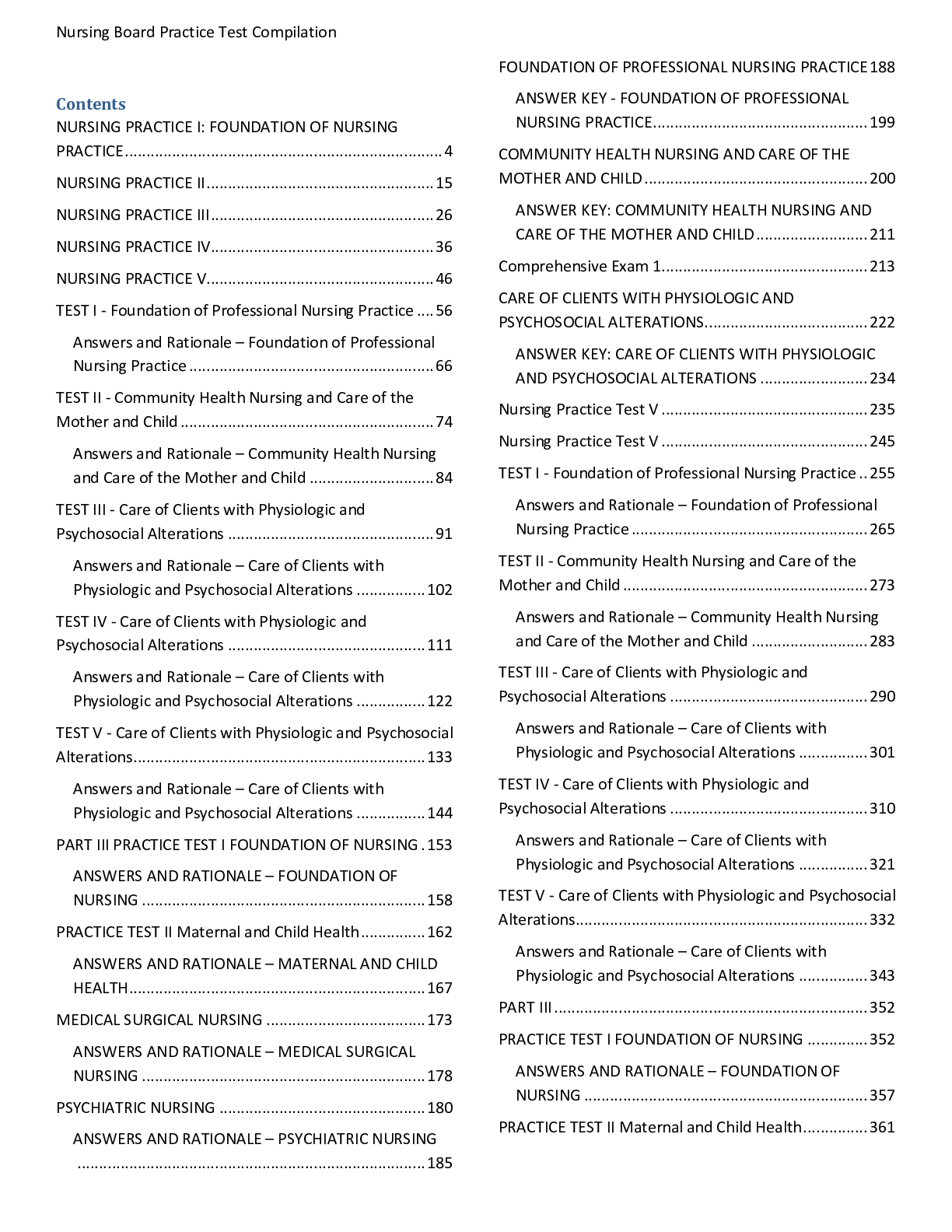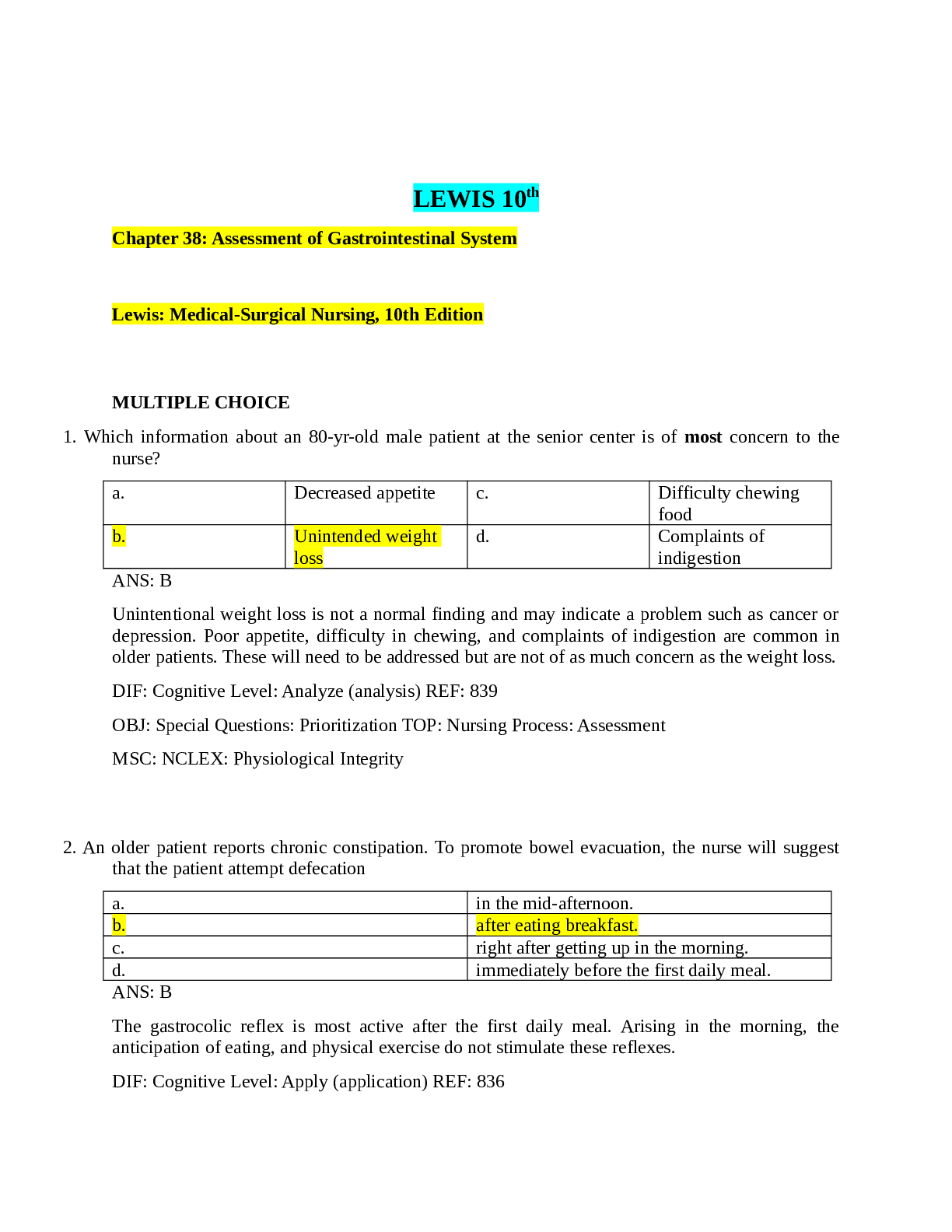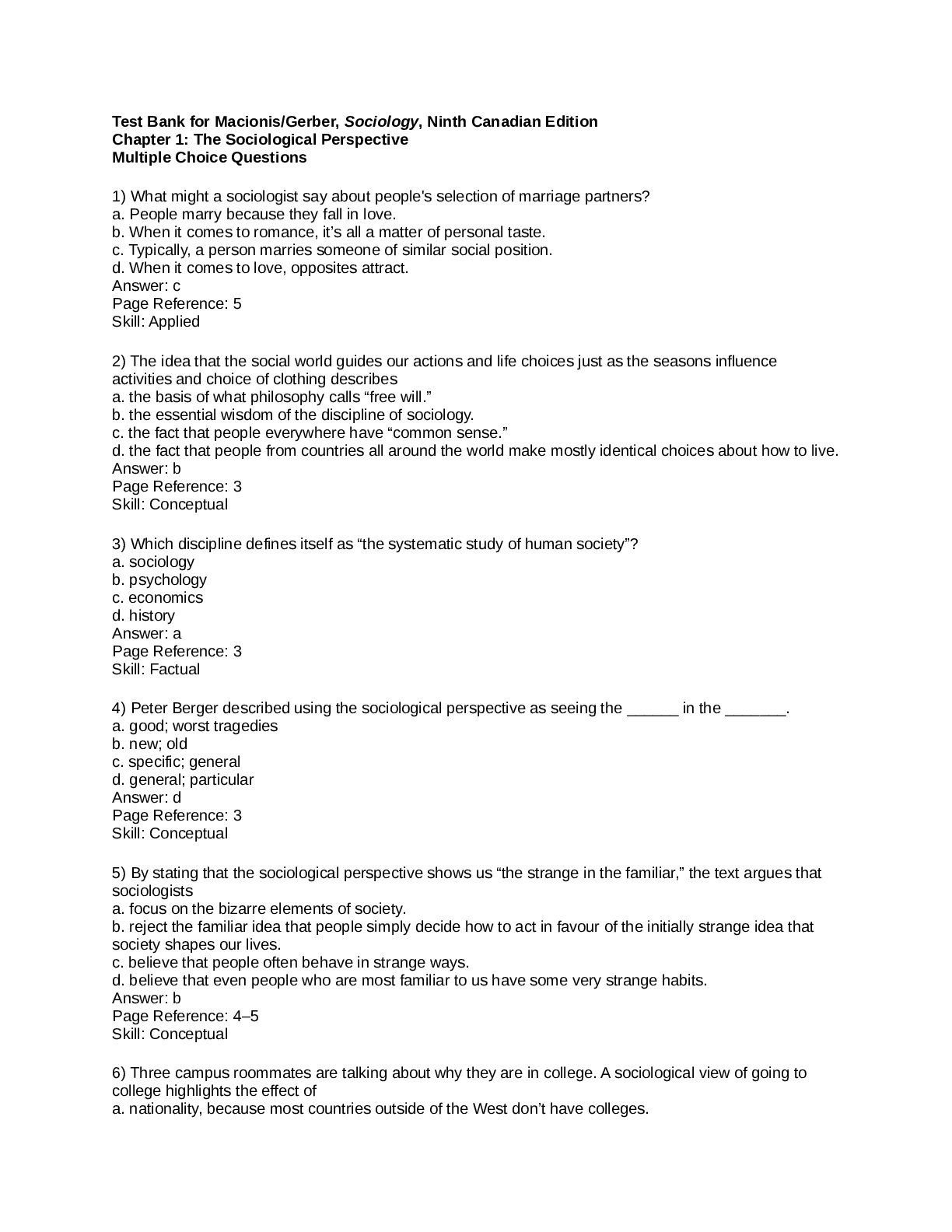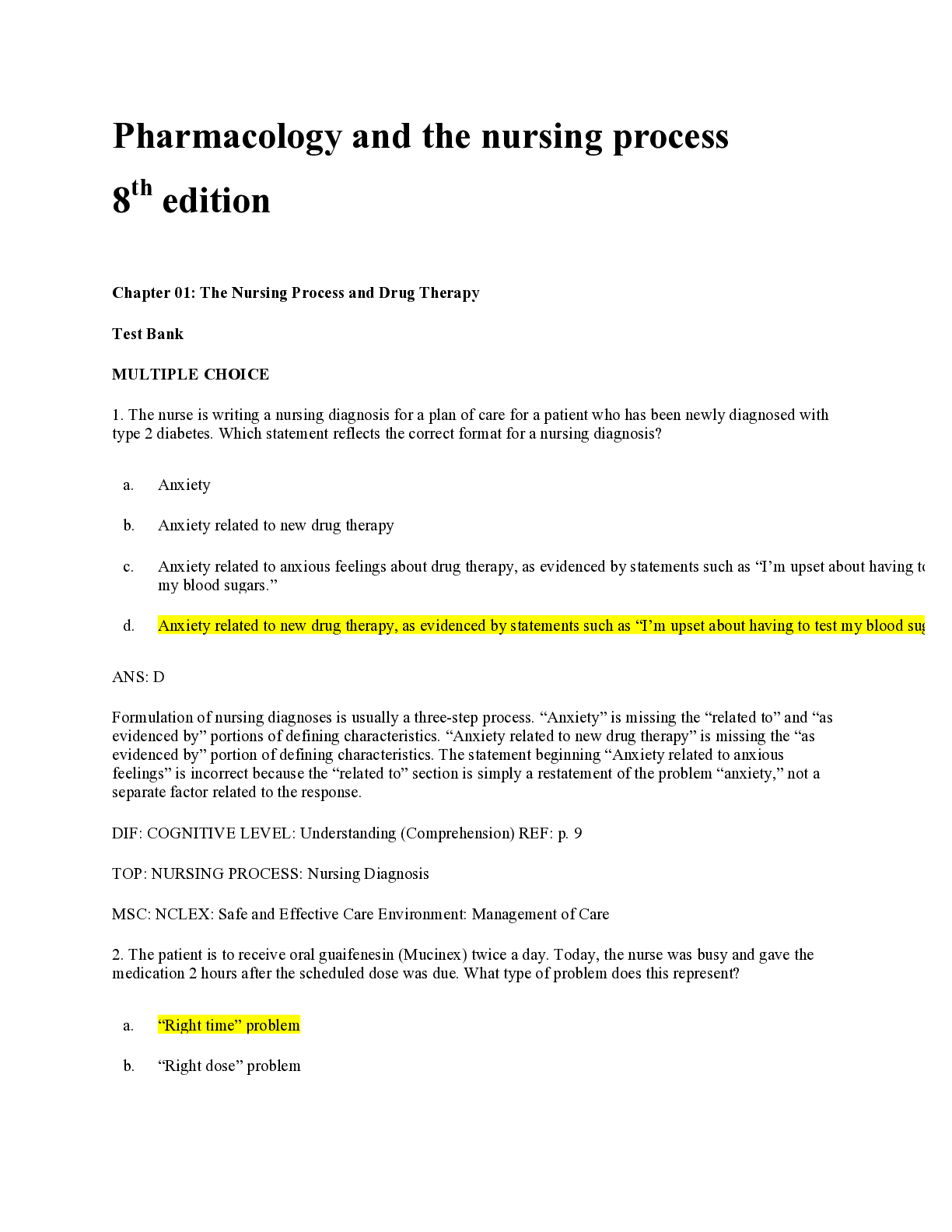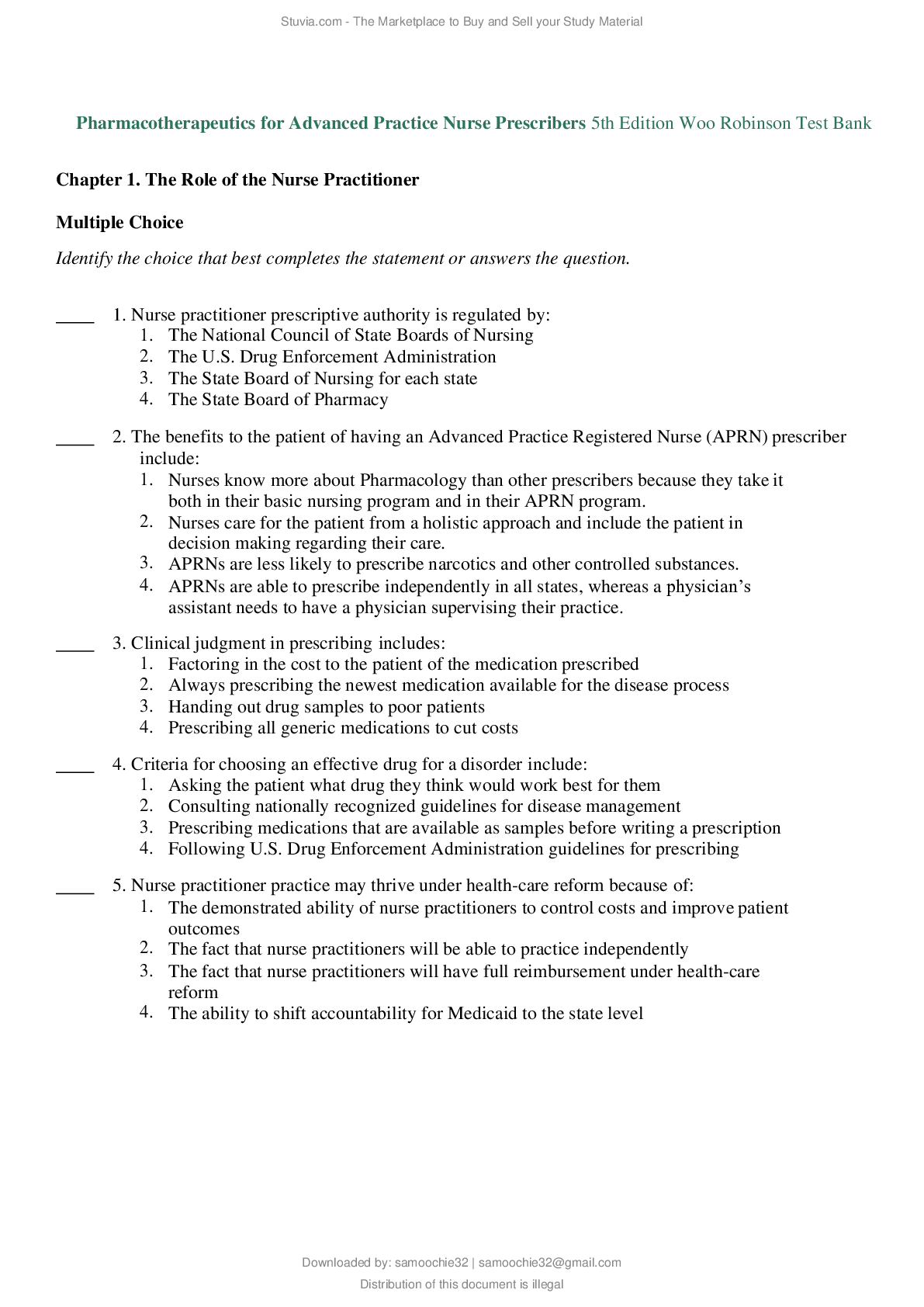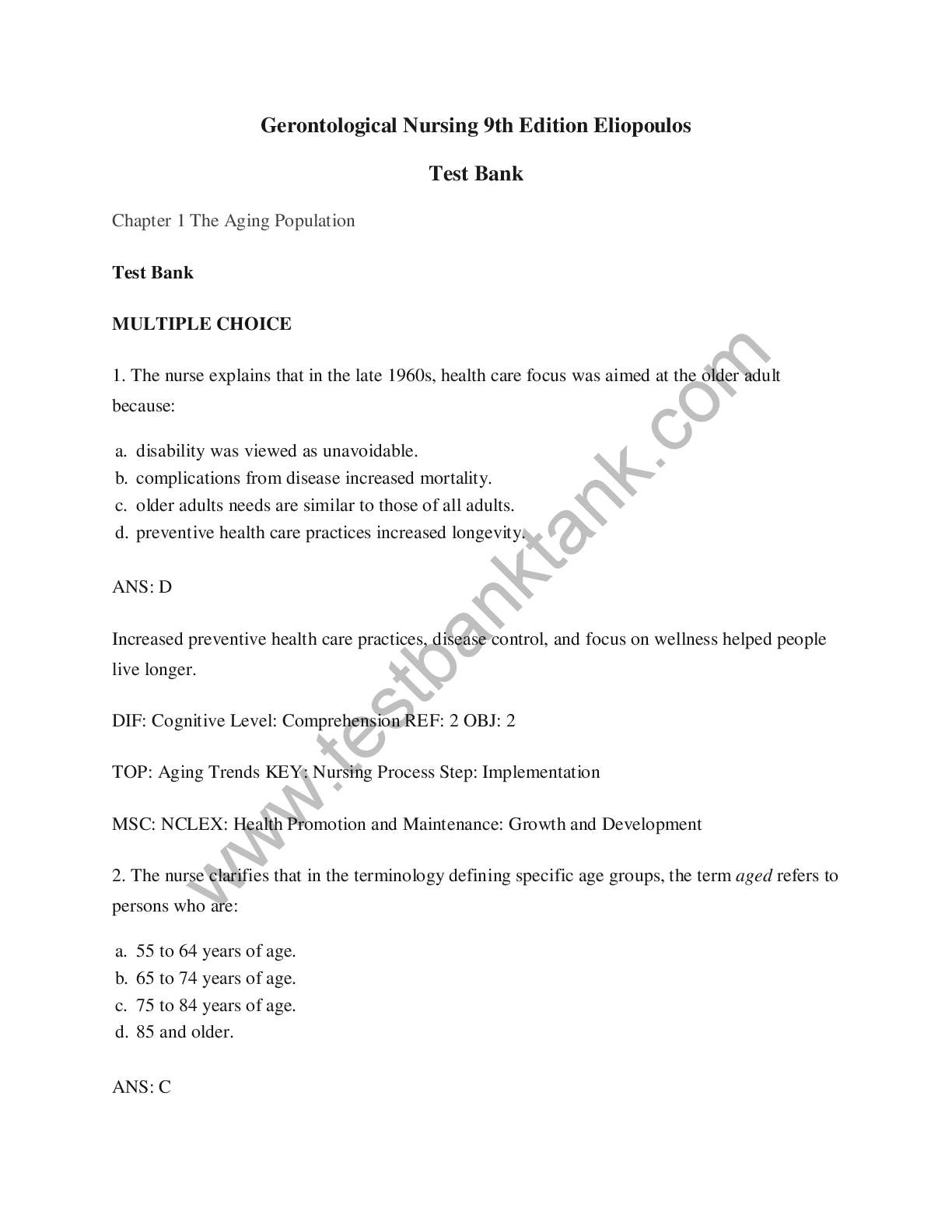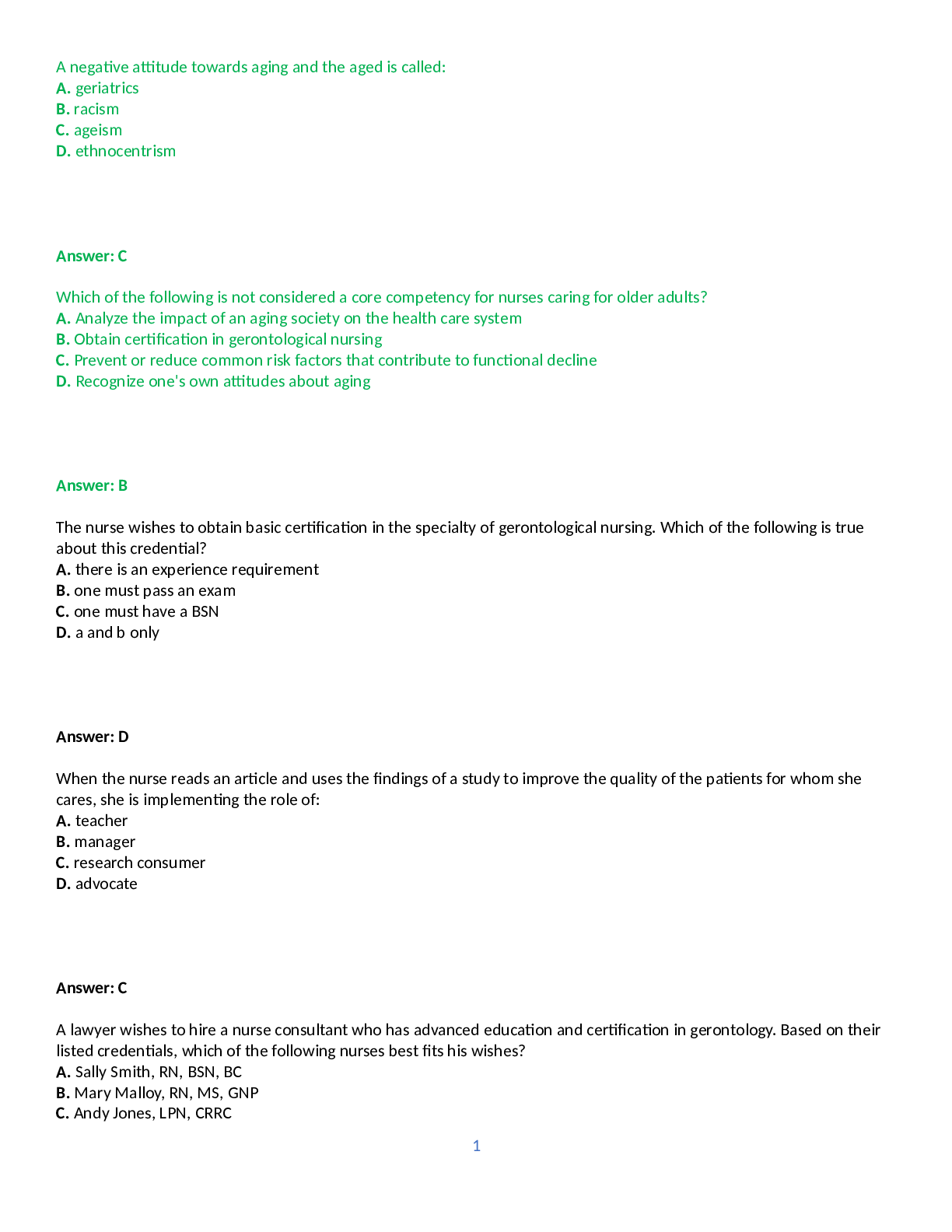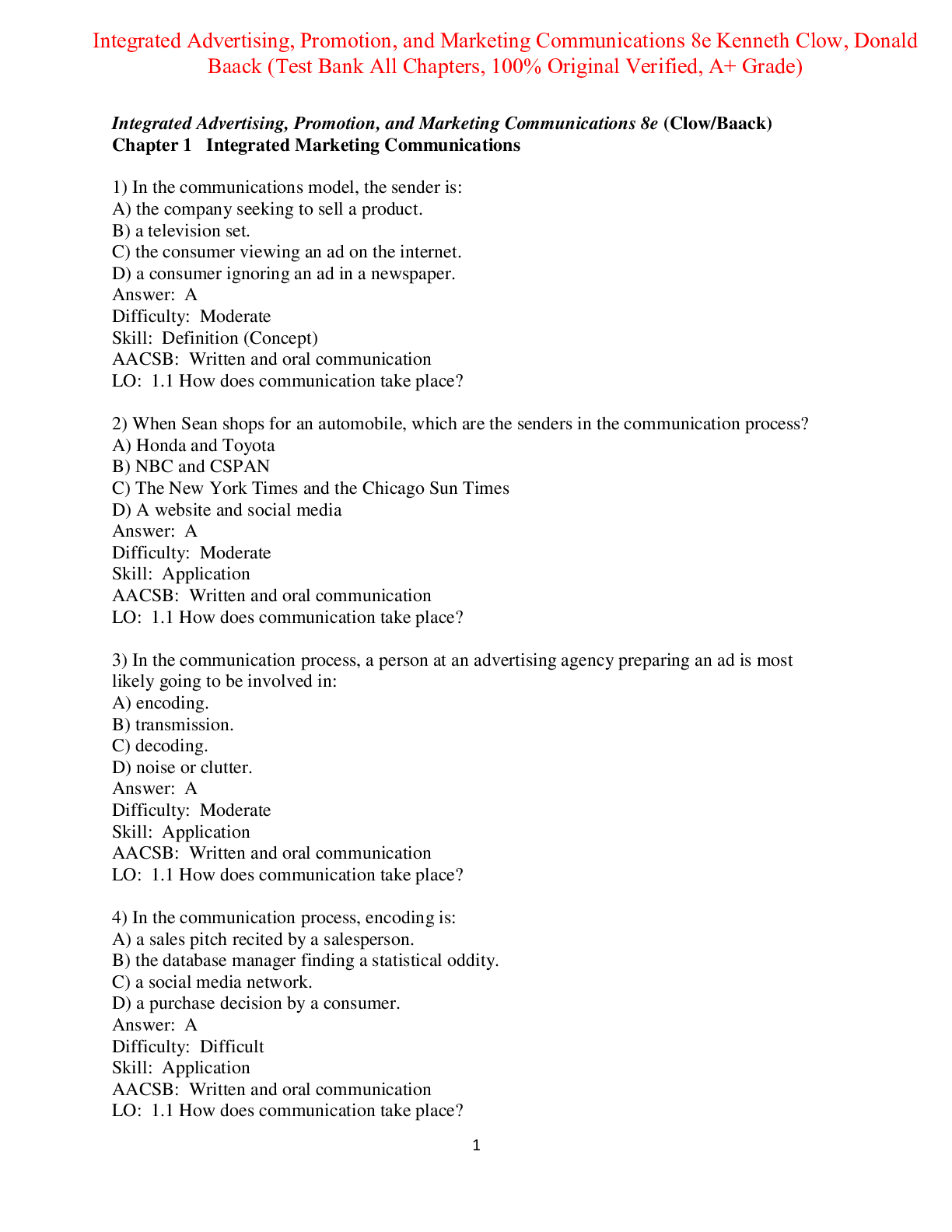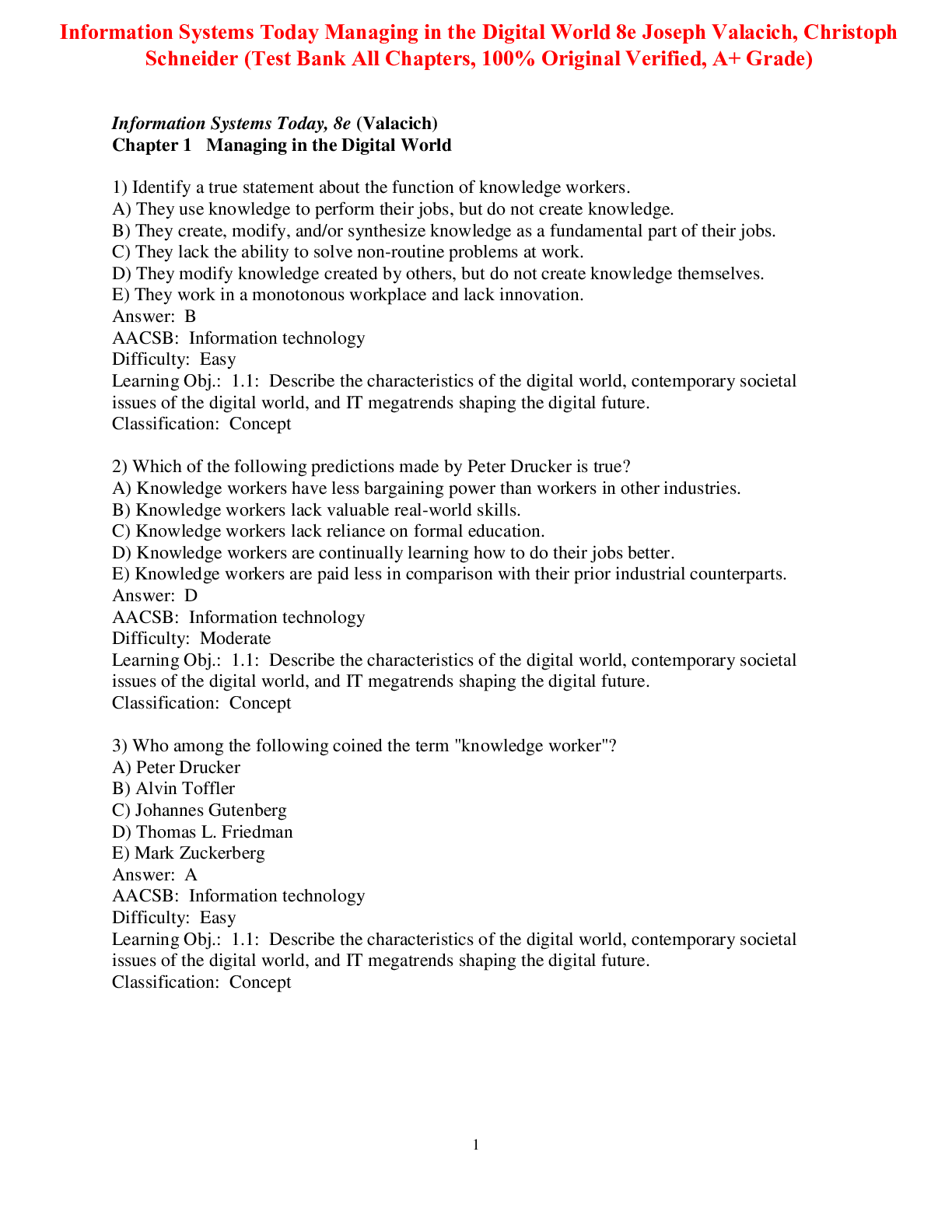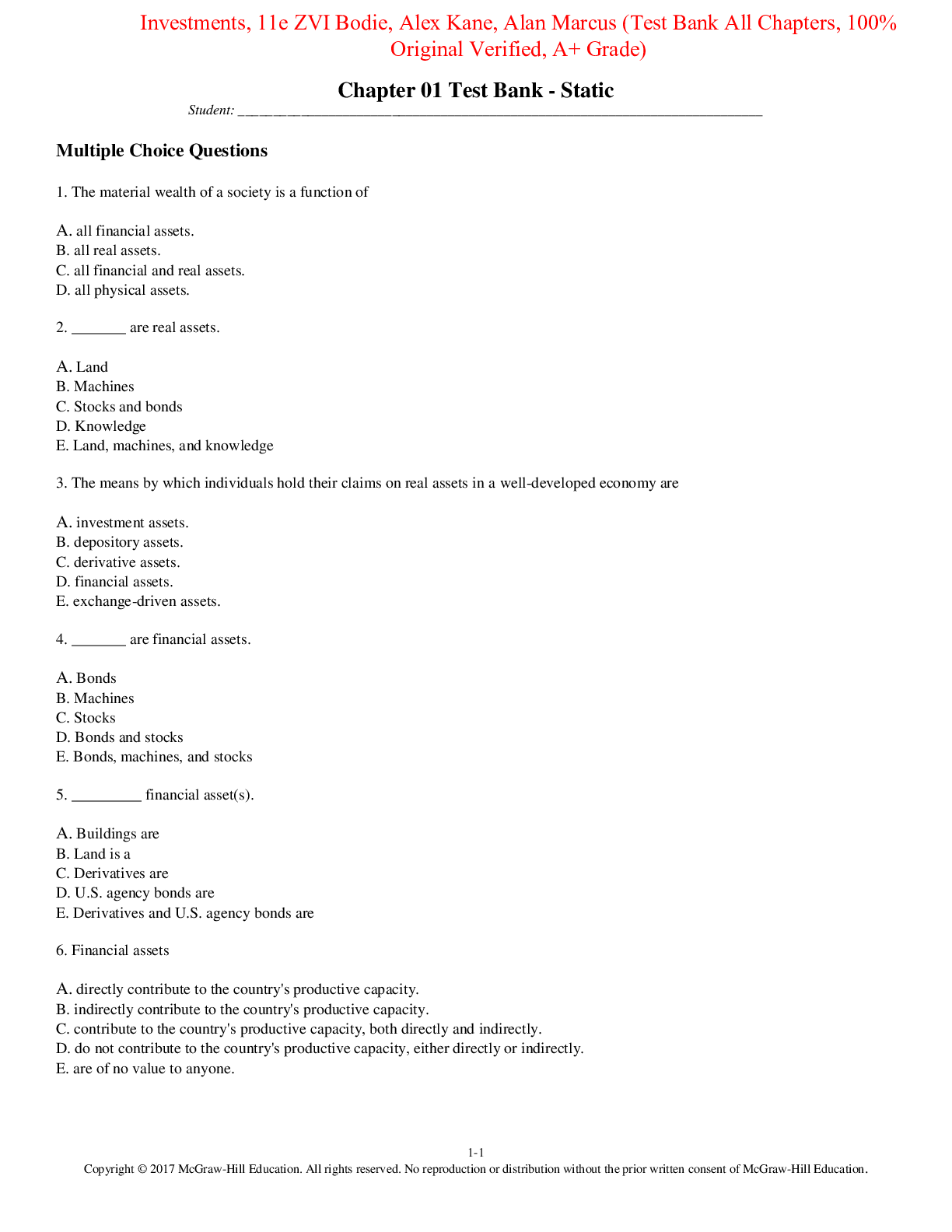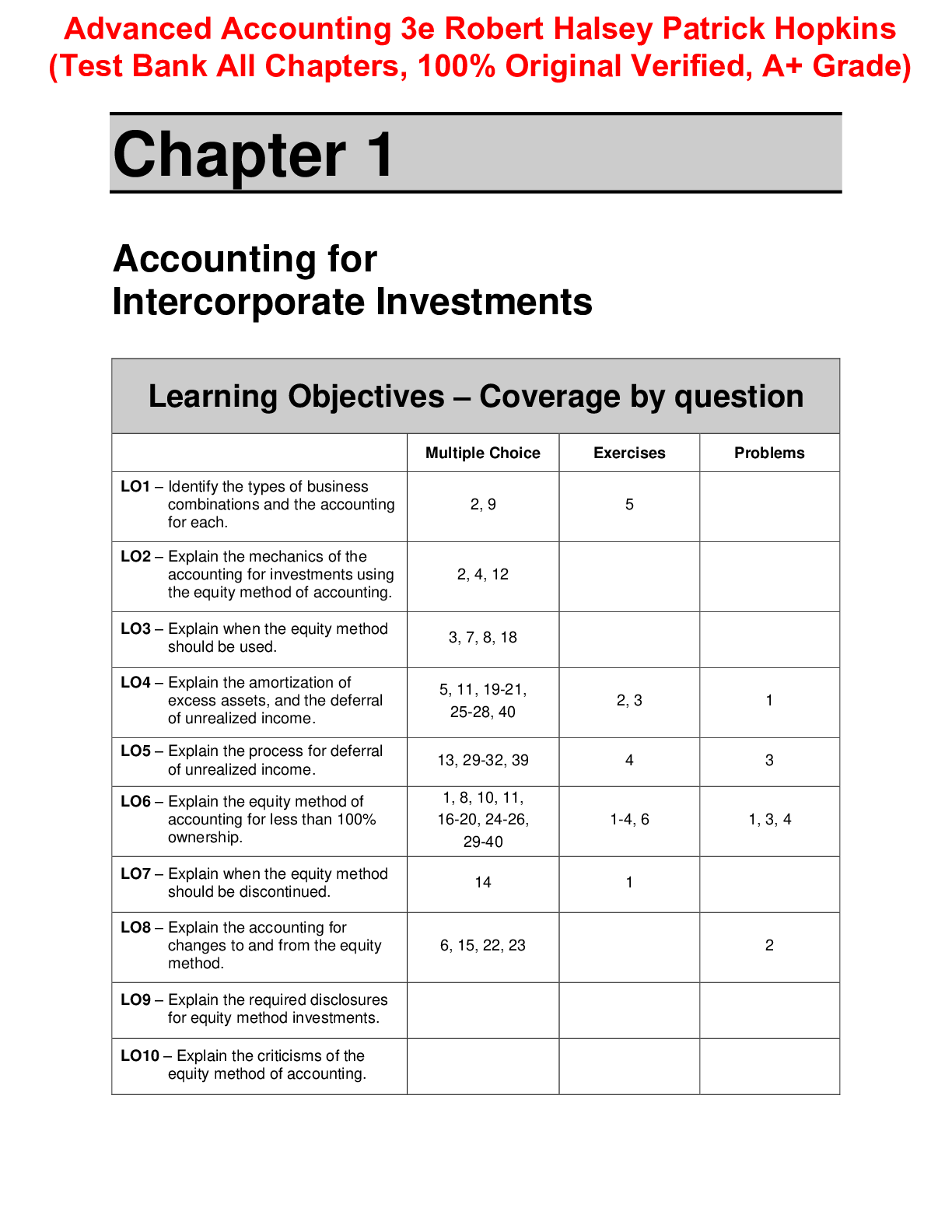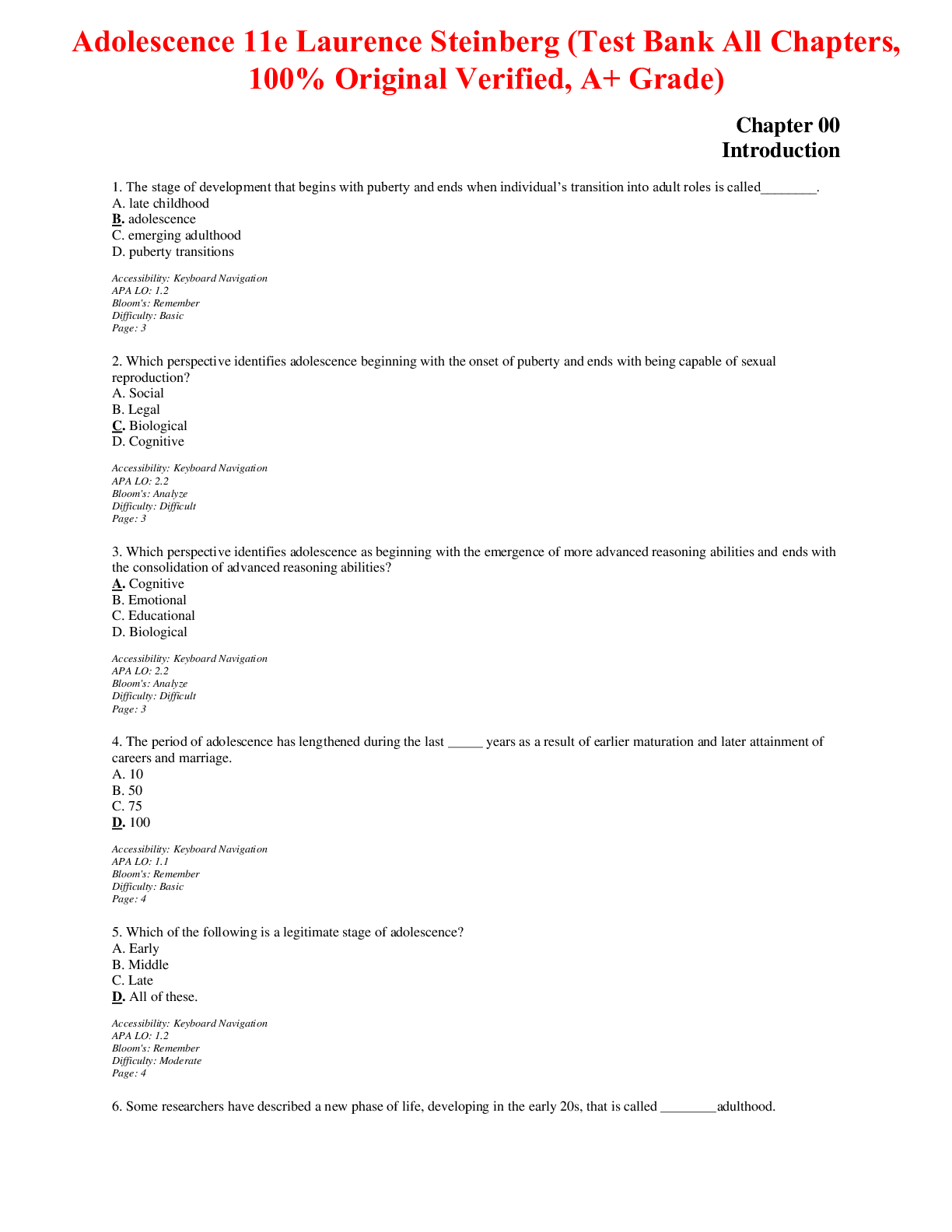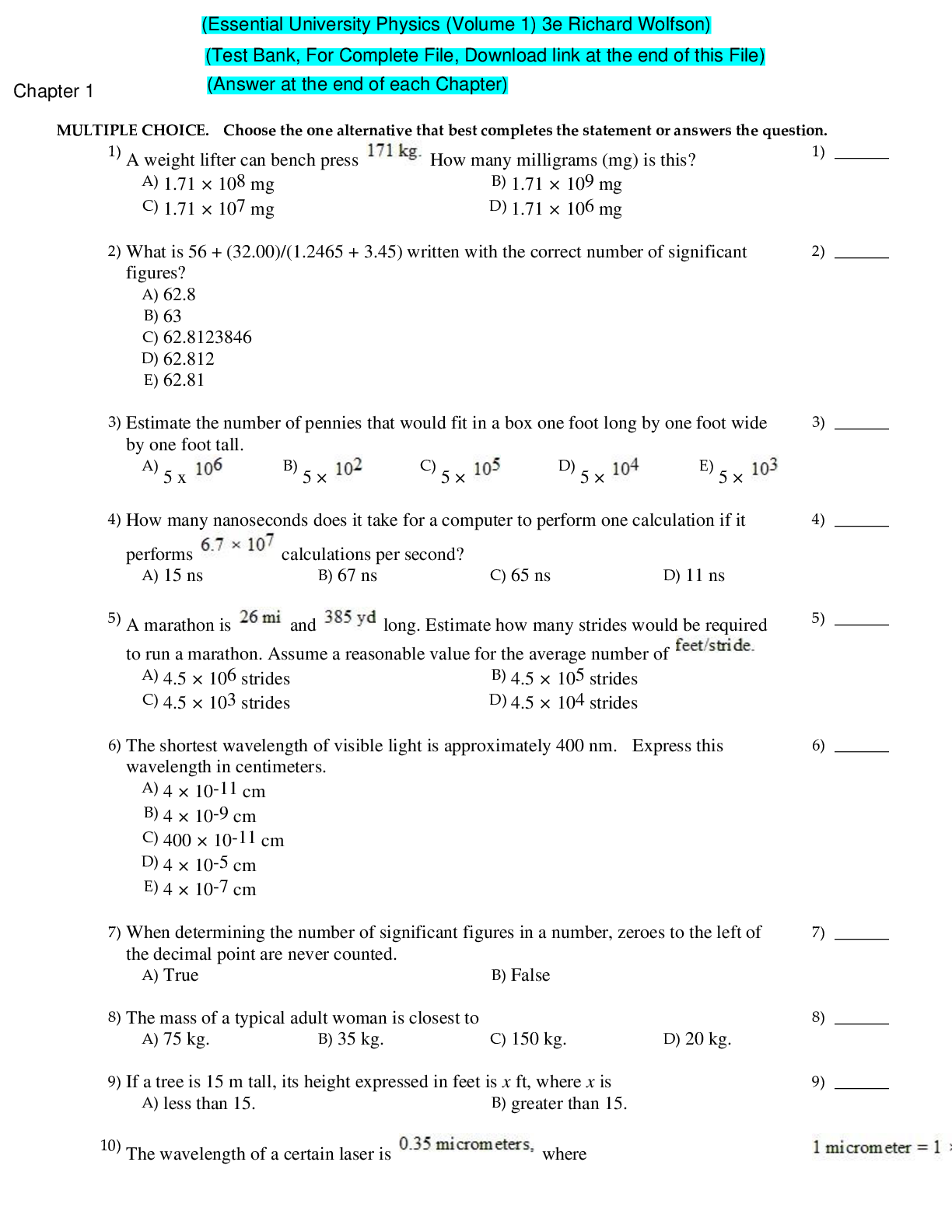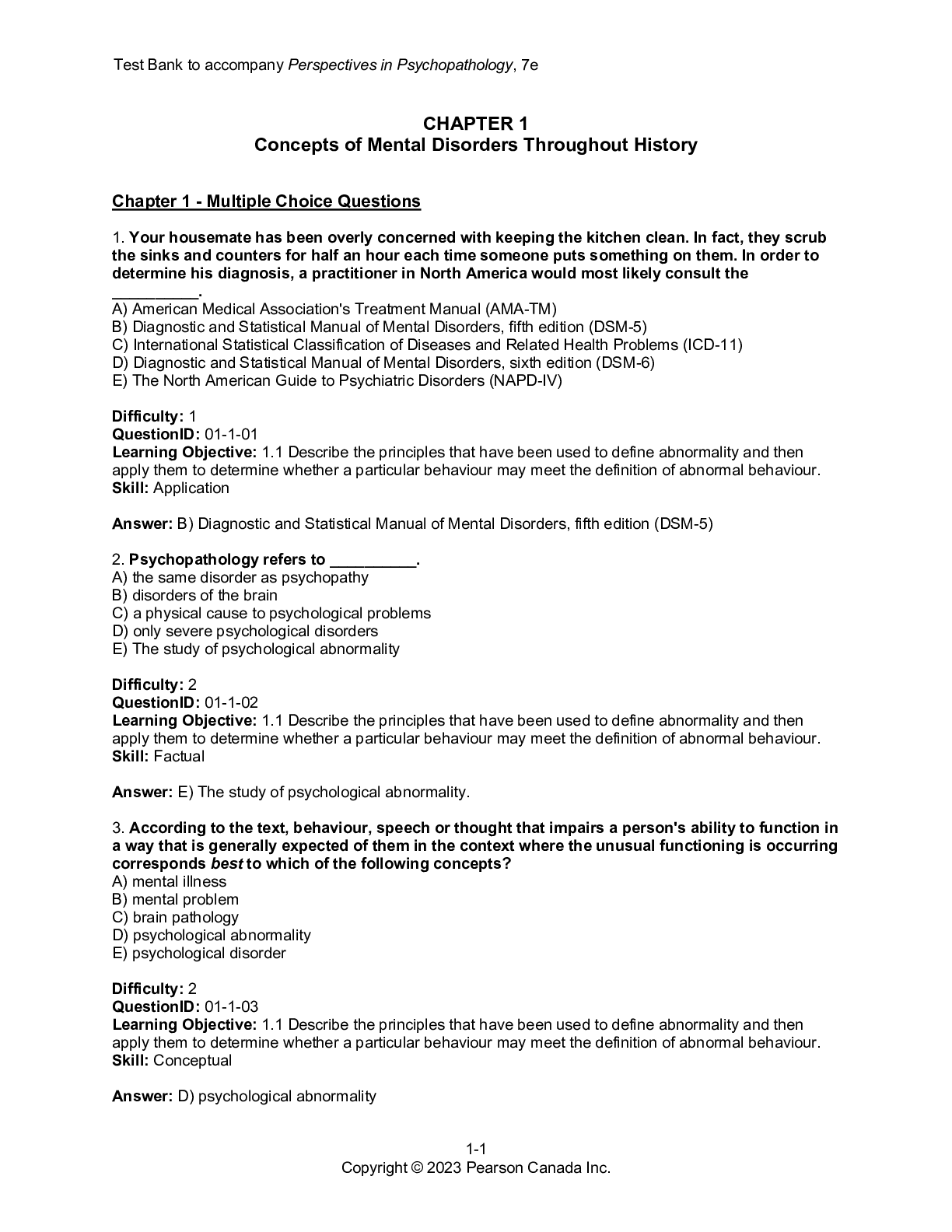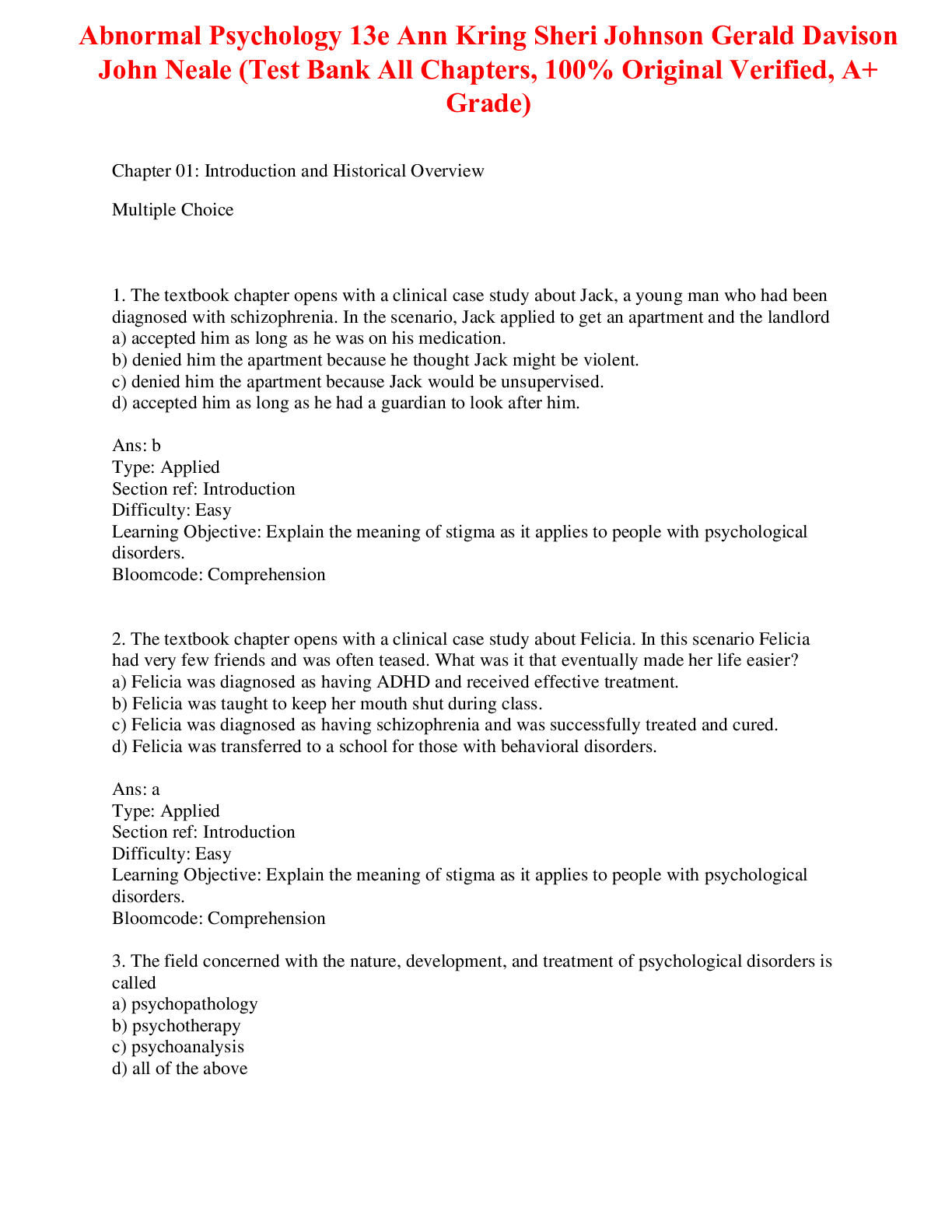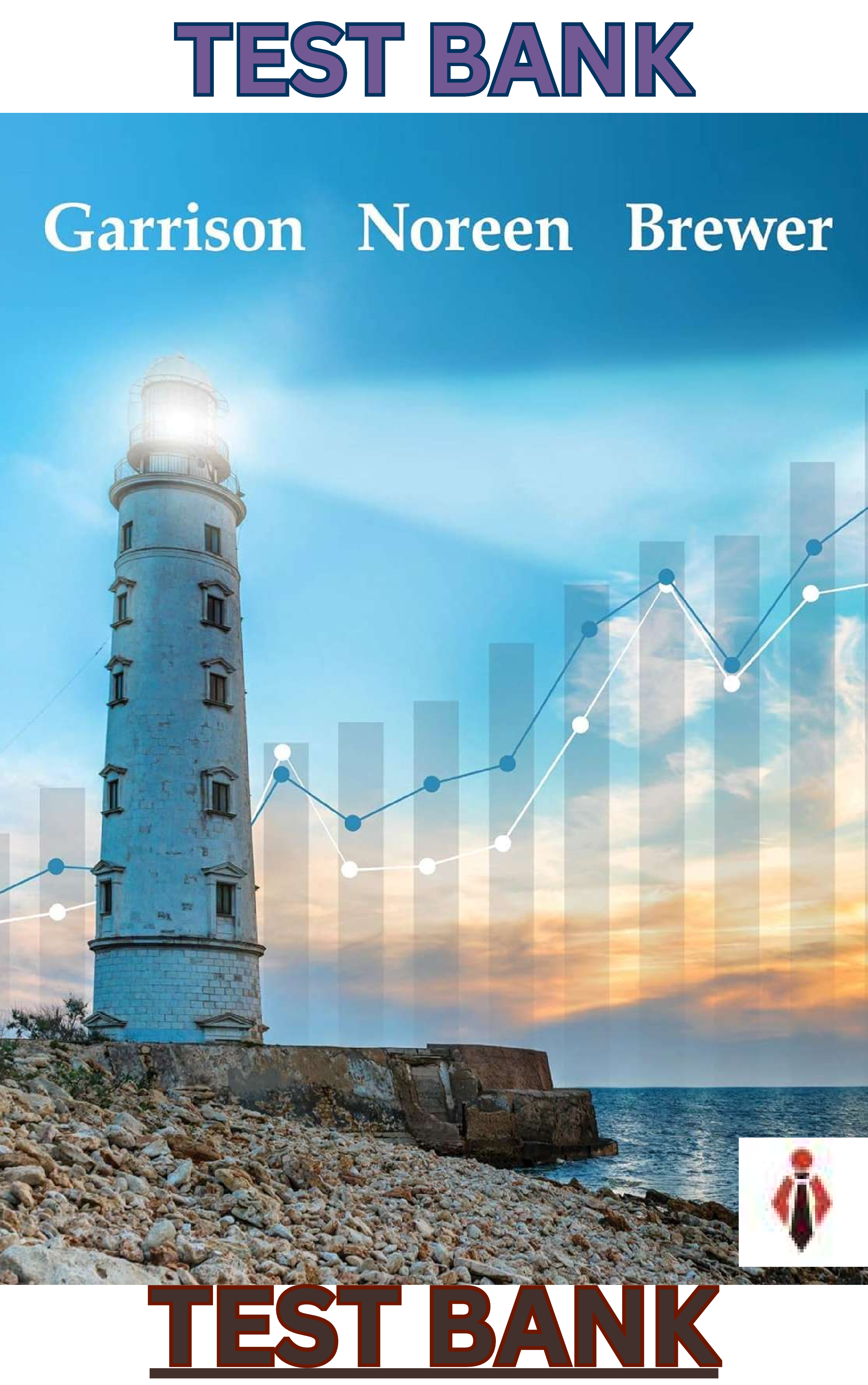*NURSING > TEST BANK > NURS 623 Exam 4 (2019/2020) test-bank complete solutions (Correctly Answered Questions, Look no furt (All)
NURS 623 Exam 4 (2019/2020) test-bank complete solutions (Correctly Answered Questions, Look no further)
Document Content and Description Below
NURS 623 Exam 4 Review Musculoskeletal problems: Evaluations of hip, shoulder, knee and ankle injuries, back and neck pain, neurological problems related to back and neck pain, gout, osteoarthritis, f... ibromyalgia, osteoporosis Neurological problems: Headaches, Seizure disorders, multiple Sclerosis, essential tremors vs. Parkinson’s Disease, Cerebrovascular Disease, Meningitis, Herpes Zoster, Trigeminal Neuralgia, Bell’s Palsy, Myasthenia Gravis NOTE: (Confusion, delirium, dementia Alzheimer’s Disease will also be part of geriatric content) Geriatrics: Delirium, dementia, syncope, vertigo, pharmacological concerns, caring for the geriatric patient; physiologic changes, psychosocial changes, ethical concerns Dunphy and Brown Text Book questions LIEK . Dunphy and brown NP review Chapter 15. Musculoskeletal Problems Multiple Choice Identify the choice that best completes the statement or answers the question. ____ 1. One of the initial steps in assessing patients with musculoskeletal complaints is to determine whether the complaint is articular or nonarticular in origin. Which of the following is an example of an articular structure? a. Bone b. Synovium c. Tendons d. Fascia ____ 2. You have detected the presence of crepitus on examination of a patient with a musculoskeletal complaint. Additionally, there is limited range of motion (ROM) with both active and passive movement. These findings suggest that the origin of the musculoskeletal complaint is: a. Articular b. Inflammatory c. Nonarticular d. A and B ____ 3. Which of the following signs or symptoms indicate an inflammatory etiology to musculoskeletal pain? a. Decreased C-reactive protein b. Hyperalbuminemia c. Morning stiffness d. Weight gain ____ 4. Which of the following statements concerning the musculoskeletal examination is true? a. The uninvolved side should be examined initially and then compared to the involved side. b. The part of the body that is causing the patient pain should be examined first. c. When possible, the patient should not be asked to perform active range-of-motion (ROM) exercises to avoid causing pain. d. Radiographs should always be obtained prior to examination so as not to cause further injury to the patient. ____ 5. You are performing muscle strength testing on a patient presenting with musculoskeletal pain and find that the patient has complete ROM with gravity eliminated. Which numeric grade of muscle strength would you give this patient? a. 1 b. 2 c. 3 d. 4 e. 5 ____ 6. Mrs. Gray is a 55-year-old woman who presents with tightness, pain, and limited movement in her right shoulder. She denies any history of trauma. Her examination reveals a 75% reduction in both active and passive ROM of the right shoulder. Mrs. Gray also is experiencing tenderness with motion and pain at the deltoid insertion. Her medical history is significant for type 1 diabetes mellitus and hypertension. Her social history reveals that she is a secretary and that she is right-handed. Based on her examination and medical history, you suspect adhesive capsulitis, or “frozen shoulder.” Which clue in Mrs. Gray’s history supports this diagnosis? a. History of hypertension b. Her affected shoulder is also her dominant arm. c. Her history of diabetes mellitus d. Her work as a secretary predisposes her to repetitive motions. ____ 7. Jennifer is an 18-year-old who comes to the emergency room after a fall during a soccer game. Jennifer explains that she fell on her left side and kept her arm out straight to break her fall. She has been experiencing severe pain and limited ROM in her left shoulder. The clinician has diagnosed Jennifer with a dislocated shoulder. Which of the following statements are true concerning shoulder dislocation? a. Posterior dislocations are more common than anterior dislocations. b. There is a risk of neurovascular and neurosensory trauma, so the clinician should check for distal pulses. c. Recurrent dislocations are uncommon and would require great force to result in injury. d. Surgery is most commonly the treatment of choice. ____ 8. Mrs. Anderson is a 35-year-old woman who has been recently diagnosed with carpal tunnel syndrome. She has two young children and asks the clinician what the chances are that they also will develop carpal tunnel syndrome. Which of the following responses would be correct regarding the risk of developing carpal tunnel syndrome? a. Carpal tunnel syndrome commonly occurs in families. Genetic factors are thought to account for about one-half the risk of developing carpal tunnel. b. Only people with occupations that require repeated flexion extension of the wrist, use of hand tools that require forceful gripping, or use of hand tools that vibrate are at risk for developing carpal tunnel. c. An underlying musculoskeletal disorder must be present for a person to develop carpal tunnel. d. Carpal tunnel syndrome only occurs in the presence of a hormonal imbalance. ____ 9. Which of the following statements is true regarding the treatment of carpal tunnel syndrome? a. The goal of treatment is to prevent flexion and extension movements of the wrist. b. Splints are used in carpal tunnel syndrome, because they allow for free movement of the fingers and thumb while maintaining the wrist in a neutral position. c. Corticosteroid injections are discouraged in the treatment of carpal tunnel syndrome because of the risks for median nerve damage, scarring, and infection. d. All of the above ____ 10. Sam is a 25-year-old who has been diagnosed with low back strain based on his history of localized low back pain and muscle spasm along with a normal neurological examination. As the clinician, you explain to Sam that low back pain is a diagnosis of exclusion. Which of the following symptoms would alert the clinician to the more serious finding of a herniated nucleus pulposus or ruptured disc? a. Morning stiffness and limited mobility of the lumbar spine b. Unilateral radicular pain symptoms that extend below the knee and are equal to or greater than the back pain c. Fever, chills, and elevated erythrocyte sedimentation rate d. Pathologic fractures, severe night pain, weight loss, and fatigue ____ 11. The clinician has instructed Sam, a 25-year-old patient with low back strain, to use NSAIDs to manage his symptoms of pain and discomfort. Which of the following statements would be most appropriate when teaching Sam about the use of NSAIDs? a. “You should start with the lowest dose that is effective in managing your pain, because long-term use of NSAIDs can result in gastrointestinal (GI) disorders such as ulcers and hemorrhage.” b. “You should start with the lowest dose that is effective in managing your pain to avoid developing tolerance to the medication.” c. “You should take the maximum recommended dose of NSAIDs so that you will not need to take narcotics to control your pain.” d. “It is important to take NSAIDs on an empty stomach in order to increase absorption.” ____ 12. Janet is a 30-year-old who has recently been diagnosed with a herniated disc at the level of L5-S1. She is currently in the emergency room with suspicion of cauda equina compression. Which of the following is a sign or symptom of cauda equina compression? a. Gastrocnemius weakness b. A reduced or absent ankle reflex c. Numbness in the lateral foot d. Paresthesia of the perineum and buttocks ____ 13. Which of the following statements is true concerning the management of the client with a herniated disc? a. Muscle relaxants and narcotics can be used to control moderate pain but should be discontinued after 3 weeks of use. b. An epidural injection is helpful in reducing leg pain that has persisted for at least 3 weeks after the herniation occurred. c. Intolerable pain for more than a 3-month period is an indication for surgical intervention. d. All of the above ____ 14. John is a 16-year-old boy who presents to the emergency room after hurting his knee in a football game. He described twisting his knee and then being unable to extend it completely. John tells the clinician that he heard a pop when the injury occurred and has been experiencing localized pain. The clinician suspects a meniscal tear. Which test would be most appropriate to assess for the presence of a meniscal tear? a. Valgus stress test b. McMurray circumduction test c. Lachman test d. Varus stress test ____ 15. The clinician suspects that a client has patellar instability. In order to test for this, the client is seated with the quadriceps relaxed, and the knee is placed in extension. Next the patella is displaced laterally, and the knee flexed to 30°. If instability is present, this maneuver displaces the patella to an abnormal position on the lateral femoral condyle, and the client will perceive pain. Testing for patellar instability in this way is known as: a. Apprehension sign b. Bulge sign c. Thumb sign d. None of the above ____ 16. The clinician is caring for Diane, a 22-year-old woman who presents with an injured ankle. Diane asks the clinician if she will need an x-ray. The clinician explains to Diane that an x-ray is not always necessary for an injured ankle and that the decision to obtain radiographs is dependent on the examination and Diane’s description of her injury. Which of the following clues in Diane’s examination or history would alert the clinician to the need for obtaining radiographs? a. Inability to bear weight immediately after the injury b. Development of marked ankle swelling and discoloration after the injury c. Crepitation with palpation or movement of the ankle d. All of the above ____ 17. Mr. Jackson is a 65-year-old man recently diagnosed with osteoarthritis. The clinician has explained to Mr. Jackson that the goals for managing osteoarthritis include controlling pain, maximizing functional independence and mobility, minimizing disability, and preserving quality of life. Mr. Jackson explains to the clinician that his first choice would be to use complementary therapies to control his condition and asks what therapies are most effective in treating osteoarthritis. What would be the most appropriate response from the clinician? a. “Complementary therapies should be considered only if surgical interventions are not successful.” b. “I am unfamiliar with the available complementary therapies for osteoarthritis and prefer to discuss more mainstream treatments, such as NSAIDs and physical therapy, to manage your condition.” c. “I would be happy to discuss all the treatment options available to you. Complementary therapies, such as acupuncture, acupressure, and tai-chi, are being studied for use in the treatment of osteoarthritis and have shown promise when used with standard medical therapy.” d. “It would be crazy to use complementary therapies to treat such a serious condition.” ____ 18. Normal estrogen function is important for preventing osteoporosis in both men and women. Estrogen works to prevent osteoporosis in which of the following ways? a. By decreasing the erosive activity of osteoclasts b. By promoting osteoclastogenesis c. By inhibiting osteoclast apoptosis d. All of the above ____ 19. Which of the following tests is considered the gold standard for definitively diagnosing osteoporosis? a. Bone alkaline phosphatase levels b. Urinary N-telopeptide assay c. Bone mass density measurement by densitometry d. Magnetic resonance imaging ____ 20. What is the recommended daily calcium intake for adults over the age of 50 with low bone mass? a. 1,200 mg/day b. 1,000 mg/day c. 1,300 mg/day d. 1,500 mg/day ____ 21. Mrs. Allen is a 60-year-old woman who has been diagnosed with osteoporosis. She is very concerned about the risk of breast cancer associated with hormone replacement therapy and is wondering what other treatments are available to her. The clinician explains that bisphosphonates are another class of drugs used in the prevention and treatment of osteoporosis. What teaching should the clinician give Mrs. Allen in regard to taking bisphosphonates? a. Taking bisphosphonates can result in hypercalcemia, so calcium intake should be decreased while taking this class of drugs. b. There is potential for upper GI irritation, so these medications are contraindicated in people with abnormalities of the esophagus or delayed esophageal emptying. c. This class of drugs can be taken at any time of the day without regard to meals. d. None of the above ____ 22. Which stage of Paget’s disease is characterized by elevated numbers of osteoblasts, resulting in abnormal increases in bone remodeling and leading to an irregular deposition of collagen fibers? a. Lytic b. Mixed c. Sclerotic d. All of the above ____ 23. Which of the following statements concerning the treatment of fibromyalgia syndrome is true? a. There is currently no cure for the disorder; however, patients should be made aware that symptom relief is possible. b. Treatment is directed toward controlling discomfort, improving sleep, and maintaining function. c. Fibromyalgia syndrome can be difficult to manage, requiring a variety of approaches and multiple medications. d. All of the above ____ 24. One of the most frequent presenting signs/symptoms of osteoporosis is: a. Goiter b. Abnormal serum calcium c. Elevated urine biochemical markers d. Bony fracture ____ 25. Mrs. Thomas was seen in the office complaining of pain and point tenderness in the area of her elbow. The pain has increased following a day of gardening one week ago. A physical finding that differentiates the diagnosis and is most consistent with lateral epicondylitis (tennis elbow) is: a. Ecchymosis, edema, and erythema over the lateral epicondyle b. Pain at the elbow with resisted movements at the wrist and forearm c. Inability to supinate and pronate the arm d. Inability to flex or extend the elbow against resistance ____ 26. A 70-year-old female has fallen 2 weeks ago and developed immediate pain in her left wrist. She thought she just bruised it but is worried because it has not improved. She has used Tylenol® and ice at home, and that has helped slightly. You examine her and find she has moderate swelling and ecchymosis but no overtly obvious deformity. Her ROM is uncomfortable and severely diminished due to the pain. No crepitus is heard or felt. Her fingers are warm; her pulse is strong; and capillary refill is less than 2 seconds. What should you do? a. Make an immediate referral for an orthopedic evaluation without further assessment. b. Tell her that it takes time for these bruises to improve, so she should be patient. c. Obtain a wrist x-ray and place her wrist in a splint or prescribe a splint. d. Send her to the emergency room for reduction of this obvious wrist fracture. True/False Indicate whether the statement is true or false. ____ 1. Osteoarthritis is primarily a noninflammatory condition. ____ 2. The presence of a positive rheumatoid factor is always indicative of rheumatoid arthritis. Chapter 15. Musculoskeletal Problems Answer Section MULTIPLE CHOICE 1. ANS: B PTS: 1 2. ANS: A PTS: 1 3. ANS: C PTS: 1 4. ANS: A PTS: 1 5. ANS: B PTS: 1 6. ANS: C PTS: 1 7. ANS: B PTS: 1 8. ANS: A PTS: 1 9. ANS: D PTS: 1 10. ANS: B PTS: 1 11. ANS: A PTS: 1 12. ANS: D PTS: 1 13. ANS: C PTS: 1 14. ANS: B PTS: 1 15. ANS: A PTS: 1 16. ANS: D PTS: 1 17. ANS: C PTS: 1 18. ANS: A PTS: 1 19. ANS: C PTS: 1 20. ANS: D PTS: 1 21. ANS: B PTS: 1 22. ANS: B PTS: 1 23. ANS: D PTS: 1 24. ANS: D PTS: 1 25. ANS: B PTS: 1 26. ANS: C PTS: 1 TRUE/FALSE 1. ANS: T PTS: 1 2. ANS: F PTS: 1 Chapter 6. Neurological Problems Multiple Choice Identify the choice that best completes the statement or answers the question. ____ 1. Which statement about confusion is true? a. Confusion is a disease process. b. Confusion is always temporary. c. Age is a reliable predictor of confusion. d. Polypharmacy is a major contributor to confusion in older adults. ____ 2. Sondra’s peripheral vestibular disease causes dizziness and vertigo. Which of the following medications will help to decrease edema in the labyrinth of the ear? a. Meclizine b. Diphenhydramine c. Diamox d. Promethazine ____ 3. The hallmark of an absence seizure is: a. No activity at all b. A blank stare c. Urine is usually voided involuntarily d. The attack usually lasts several minutes ____ 4. How often should drug levels be monitored when a seizure medication has controlled the seizures, and the drug level is adequate? a. Every 3 months b. Every 6 months c. Annually d. Whenever there is a problem ____ 5. Which of the following persons fits the classic description of a patient with multiple sclerosis (MS)? a. A teenage male b. A 65-year-old male c. A 25-year-old female d. A 60-year-old female ____ 6. Which of the following is a specific test to MS? a. Magnetic resonance imaging (MRI) b. Computed tomography (CT) scan c. A lumbar puncture d. There is no specific test. ____ 7. Which drug for Alzheimer’s disease should be administered beginning at the time of diagnosis? a. Cholinesterase inhibitors b. Anxiolytics c. Antidepressants d. Atypical antipsychotics ____ 8. Which hematoma occurs along the temporal cranial wall and results from tears in the middle meningeal artery? a. Epidural hematoma b. Subdural hematoma c. Subarachnoid hematoma d. Intraparenchymal hemorrhage ____ 9. Which cranial nerve is affected in a patient with a cerebrovascular accident who has difficulty chewing? a. CN V b. CN VII c. CN IX d. CN X ____ 10. Which statement best describes a carotid bruit? a. It is felt with the middle three fingers over the carotid artery. b. A bruit becomes audible when the lumen is narrowed to 1 mm or less. c. A low-pitched bruit is a medical emergency. d. The higher the pitch of the bruit, the higher the degree of stenosis. ____ 11. Which patient is more likely to have a cluster headache? a. A female in her reproductive years b. A 40-year-old African American male c. A 55-year-old female who drinks 10 cups of coffee daily d. A 45-year-old male awakened at night ____ 12. Inattention and a sleep-wake cycle disturbance are the hallmark symptoms of? a. Dementia b. Alzheimer’s disease c. Parkinson’s disease d. Delirium ____ 13. Which type of meningitis is more benign, self-limiting, and caused primarily by a virus? a. Purulent meningitis b. Chronic meningitis c. Aseptic meningitis d. Herpes meningitis ____ 14. Which is the most sensitive neuroimaging test to evaluate patients with encephalitis? a. MRI b. CT c. Electroencephalogram (EEG) d. An initial lumbar puncture ____ 15. What is usually the first sign or symptom that a patient would present with that would make you suspect herpes zoster? a. A stabbing pain on one small area of the body b. A vesicular skin lesion on one side of the body c. A pain that is worse upon awakening d. A lesion on the exterior ear canal ____ 16. Gabby, aged 22, has Bell’s palsy on the right side of her face. Her mouth is distorted, and she is concerned about permanent paralysis and pain. What do you tell her? a. “Most patients have complete recovery in 3 to 6 months.” b. “Unfortunately, you’ll probably have a small amount of residual damage.” c. “Don’t worry, I’ll take care of everything.” d. “You may have a few more episodes over the course of your lifetime but no permanent damage.” ____ 17. Sam, aged 65, is started on L-dopa for his Parkinson’s disease (PD). He asks why this is necessary. You tell him: a. “L-dopa is neuroprotective.” b. “The primary goal of therapy is to replace depleted stores of dopamine.” c. “This is the only drug that can provide symptomatic benefit.” d. “This is the initial monotherapy drug.” ____ 18. Which of the following signs is seen in a patient with more advanced PD? a. Resting tremor b. Bradykinesia c. Rigidity d. Postural instability ____ 19. Which of the following is the most commonly experienced symptom of migraine? a. Light sensitivity b. Pulsatile pain c. Sound sensitivity d. Experiencing an aura ____ 20. Which of the following characteristics differentiates peripheral vertigo from central vertigo? a. The duration of central vertigo is shorter than that of peripheral vertigo. b. There is an auditory-associated symptom with peripheral vertigo and a visual-associated symptom with central vertigo. c. Central vertigo is positional, and peripheral vertigo is not. d. The onset of central vertigo is more sudden than that of peripheral vertigo. ____ 21. Carotid endarterectomy should be considered only for symptomatic patients with greater than what percentage of stenosis? a. Greater than 25% b. Greater than 50% c. Greater than 75% d. Only for 100% occlusion ____ 22. What antiplatelet agent is most widely used for secondary prevention of stroke? a. Aspirin b. Ticlopidine c. Clopidogrel d. Aspirin and clopidogrel ____ 23. Which adjunctive diagnostic test should be used in the work-up of a patient with suspected Creutzfeldt-Jakob disease or transient epileptic amnesia? a. MRI b. CT c. Cerebrospinal fluid analysis d. EEG ____ 24. Which herbal preparation may cause delirium and should be avoided in an elderly patient? a. Sam-e b. Saint John’s Wort c. Melatonin d. Saw Palmetto ____ 25. Which of the following activities is part of the functional activities questionnaire? a. Asking the patient to unravel a Rubik’s cube b. Determining if the patient can drive on the highway c. Asking the patient about a news event from the current week d. Seeing if the patient can keep his or her home clean ____ 26. About 90% of all headaches are? a. Tension b. Migraine c. Cluster d. Without pathological cause ____ 27. Which statement is true regarding driving and patients with a seizure disorder? a. Once diagnosed with a seizure disorder, patients must never drive again. b. After being seizure free for 6 months, patients may drive. c. Each state has different laws governing driving for individuals with a seizure disorder. d. These persons may drive but never alone. ____ 28. Julie has relapsing-remitting muscular sclerosis. She has not had a good response to interferon. Which medication might help given intravenously once a month? a. Glatiramer acetate b. Natalizumab c. Fingolimod d. Glucocorticoids ____ 29. The ‘freezing phenomenon’ is a cardinal feature of? a. Parkinson’s disease b. Alzheimer’s disease c. A CVA d. Bell’s palsy ____ 30. A ratchet-like rhythmic contraction, especially in the hand, during passive stretching is known as? a. Spinothalamic dysfunction b. Ratcheting c. Cogwheeling d. Hand tremors ____ 31. Clinical features of insidious onset, slow progression, and a lack of other findings to explain the symptoms are fairly diagnostic of which condition? a. Guillain-Barré syndrome b. Parkinson’s disease c. Alzheimer’s disease d. Huntington’s disease ____ 32. Which condition is characterized by the impaired ability to learn new information along with either a cognitive disturbance in language, function, or perception? a. Guillain-Barré syndrome b. Parkinson’s disease c. Alzheimer’s disease d. Delirium ____ 33. A score of 20 to 25 on this test indicates early-stage Alzheimer’s disease: a. SLUMS b. MoCA c. FAST d. MMSE ____ 34. Intravenous thrombolytic therapy following an ischemic CVA should be given within how many hours of symptom onset? a. 1 hour b. 3 hours c. 6 hours d. 12 hours ____ 35. When administered at the beginning of an attack, oxygen therapy may help this kind of headache? a. Tension b. Migraine c. Cluster d. Stress Chapter 6. Neurological Problems Answer Section MULTIPLE CHOICE [Show More]
Last updated: 1 year ago
Preview 1 out of 66 pages
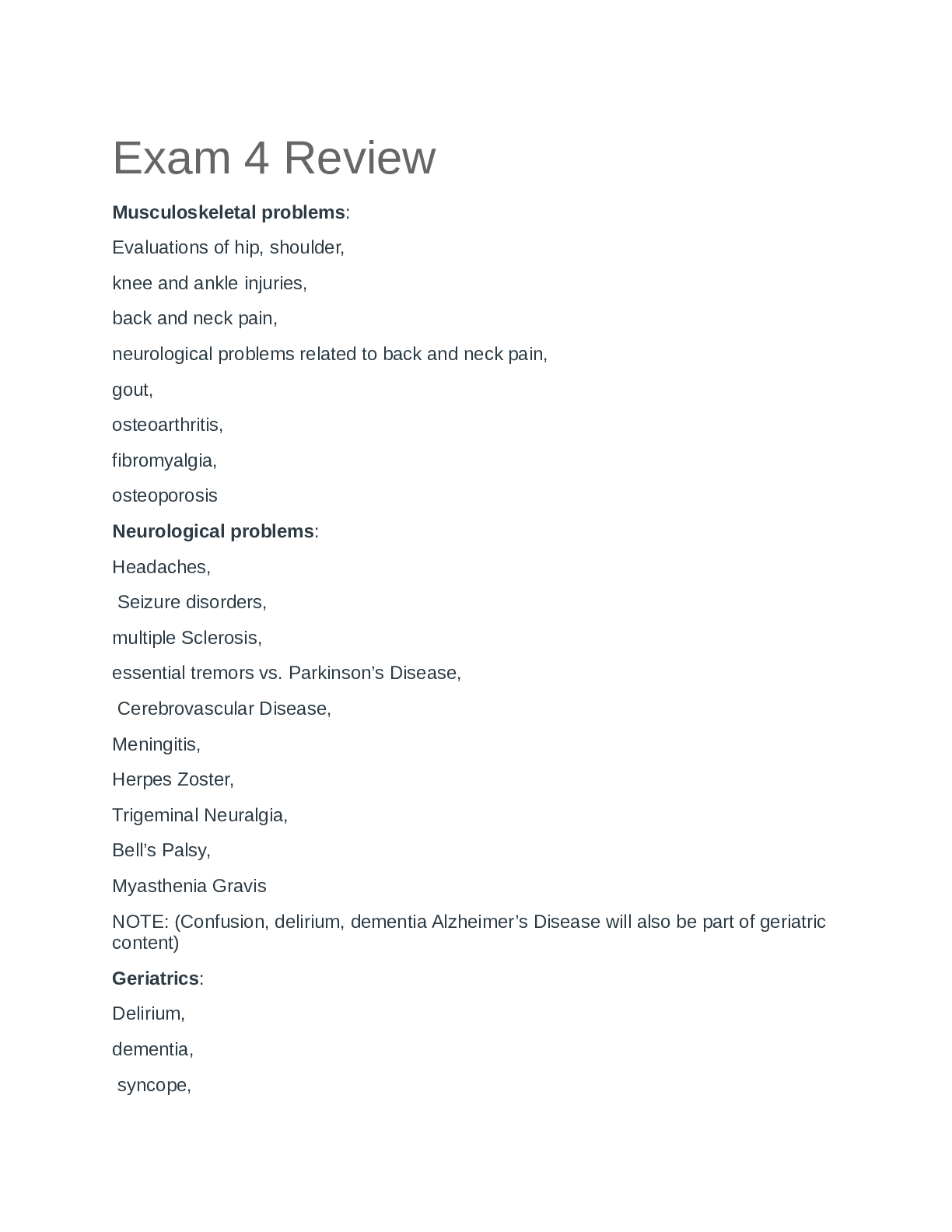
Reviews( 0 )
Document information
Connected school, study & course
About the document
Uploaded On
Nov 13, 2021
Number of pages
66
Written in
Additional information
This document has been written for:
Uploaded
Nov 13, 2021
Downloads
0
Views
46

